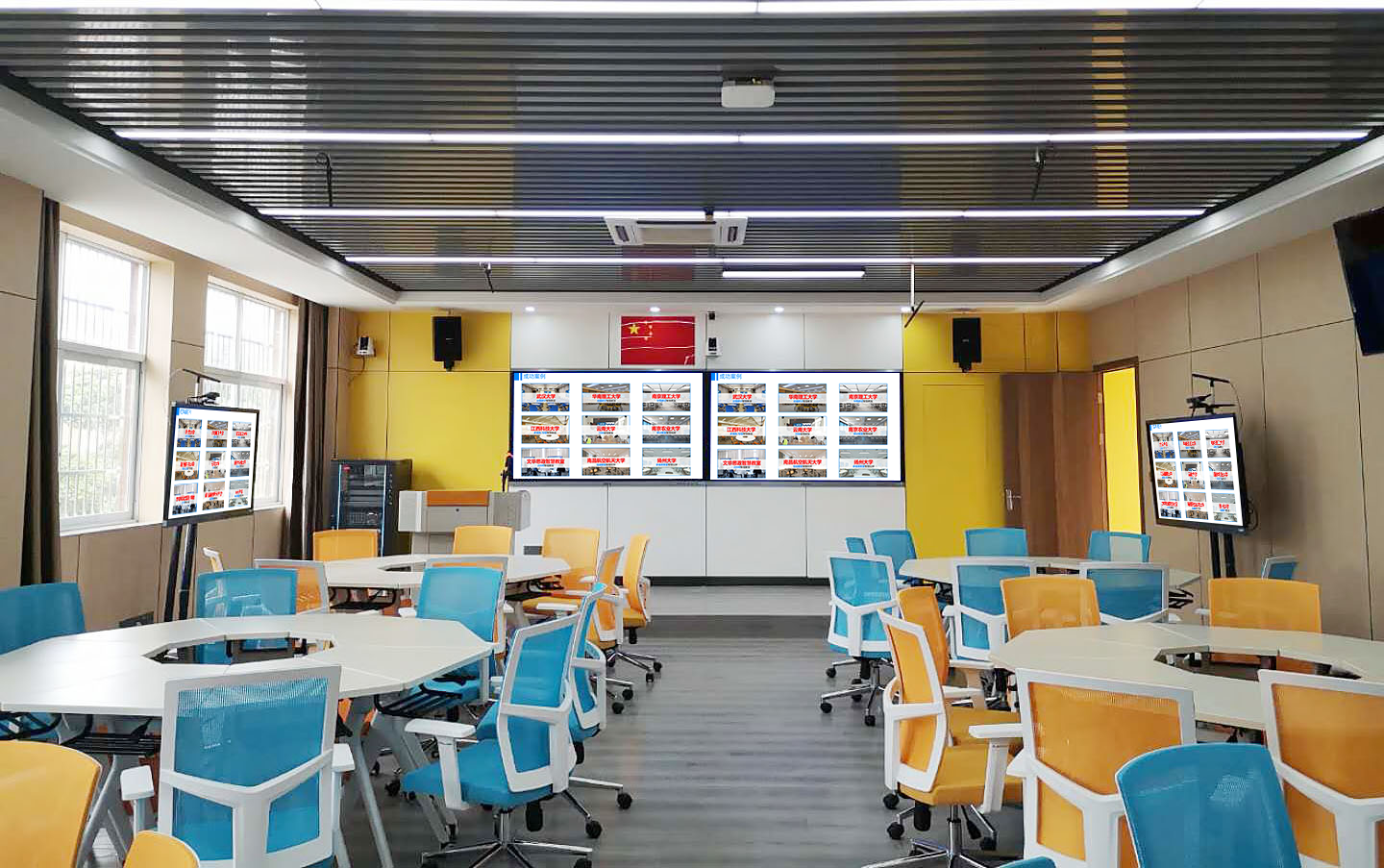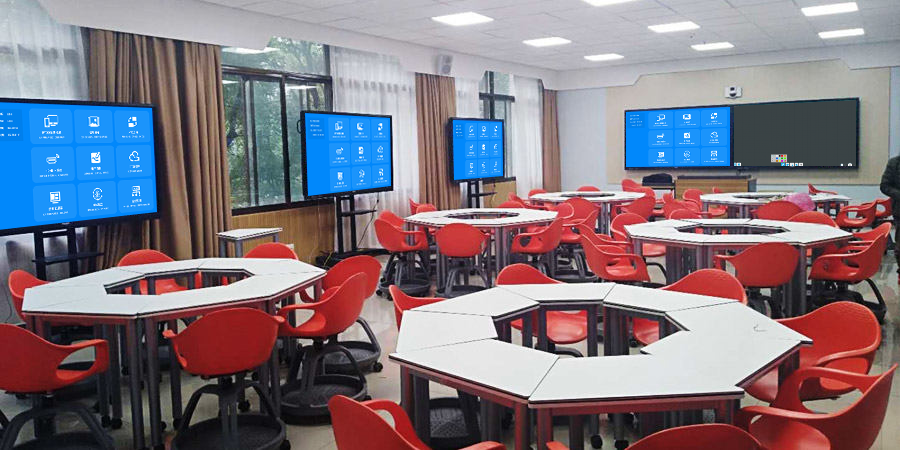Group Discussions: More Efficient Collaboration and Sharing
Struggling with group discussion pain points like “difficulty syncing team results and time-consuming cross-team communication”? This screen mirroring device solves them effortlessly! It supports independent mirroring for multiple groups, one-click result sharing, and real-time annotation interactions, covering scenarios such as corporate project discussions, training groups, and academic exchanges. No complex settings required—transform discussions from “dispersed and inefficient” to “collaborative and efficient,” even for beginners to master quickly.
I.Minute Setup for Discussion Scenarios: Zero Technical Threshold
Simple enough for all age groups to learn in seconds:
Multi-Screen Quick Networking
Connect screen mirroring receivers to each group’s secondary screen and the main display screen respectively. After powering on, they automatically assign identifiers (e.g., “Group 1 Discussion Screen,” “Group 2 Discussion Screen,” “Main Display Screen”). Participants connect their computers/tablets to the discussion area’s WiFi (or the mirroring device’s hotspot if offline)—no drivers or software installation needed, and multi-device interconnection is completed in 10 seconds.
Independent Group Mirroring
Each group can mirror independently: Click “Project” on a computer to select the corresponding group’s secondary screen, or pull down the control center on a mobile phone and tap “Screen Mirroring” to connect. Connection takes 1-2 seconds, allowing groups to display ideas and annotate plans in real time without mutual interference. The main display screen temporarily stores all groups’ content to be presented uniformly after discussions conclude.
II.Core Advantages: Precisely Adapted to Group Discussion Needs
1. Independent Mirroring for Multiple Groups: No Interrupted Collaboration
- Supports independent mirroring for 3–8 groups simultaneously. Each group’s secondary screen only shows its own content (e.g., Group 1 analyzes market data, Group 2 designs promotion plans). Team members can focus on discussions and real-time revisions (computers for frameworks, tablets for details, mobile phones for handwritten ideas), avoiding cross-group interruptions and boosting focus by 50%.
- Multi-device relay mirroring within a group: Member A mirrors a preliminary plan framework via computer, Member B supplements user portraits via tablet, and Member C shares competitor cases via mobile phone. Seamless content transition eliminates repeated device plugging/unplugging, ensuring smooth collaboration—groups can complete initial discussions in just 15 minutes.
2. One-Click Result Sharing: Smoother Cross-Team Communication
- After a group finishes discussing, click “Push to Main Screen” on the mirroring device to sync results to the main display in 1 second for all to view. No need for team representatives to “take turns going on stage to plug in devices,” saving 30% of result-sharing time. For example, 5 groups only need 2 minutes to sync all results, avoiding the inefficiency of “waiting for presentations” in traditional discussions.
- Supports “split-screen comparison of multi-group results”: The main display can show 2–4 groups’ core plans simultaneously (e.g., Group 1 on the left, Group 2 on the right, Group 3 at the top, Group 4 at the bottom). Differences (e.g., budget allocation, implementation cycles) are clear at a glance. Cross-team communication requires no repeated content switching, enabling direct idea collisions and rapid integration of strengths.
3. Real-Time Interactive Annotations: Deeper Discussions
- After each group’s results are mirrored, the host can use a tablet to annotate revision suggestions on the main screen (e.g., “User research data needs supplementing here,” “Implementation steps can be optimized”). Annotations sync back to the corresponding group’s secondary screen, allowing real-time plan adjustments—no need for “note-taking and secondary revisions,” boosting feedback efficiency by 60%.
- During cross-team questions, questioners can take photos of their group’s supplementary ideas (e.g., “Our cost control method can be referenced”) via mobile phone and mirror them to the main screen with one click. The corresponding group can respond in real time on their secondary screen (annotating “This method fits specific scenarios” via computer). Interaction requires no “loud shouting,” keeping the discussion focused and free from irrelevant distractions.

III.Full-Scenario Implementation: Empowering Group Discussions Across Fields
1. Corporate Project Discussions: More Accurate Decision-Making
- The marketing department splits into groups to discuss new product promotion plans: Group 1’s secondary screen shows channel planning (online-offline ratio), Group 2’s shows budget allocation (cost proportion per channel), and Group 3’s shows risk response strategies. After discussions, results are pushed to the main screen for split-screen comparison. The host annotates “Channel overlaps need optimization” and “Budget should tilt toward high-conversion channels,” enabling rapid cross-team integration of strengths and 50% faster plan refinement.
- Product R&D groups discuss feature design: Each group mirrors prototypes to secondary screens, and members use styluses to annotate interaction logic (e.g., “Button position needs adjustment,” “Process can be simplified”). After results are pushed to the main screen, the technical team directly annotates technical feasibility (e.g., “This interaction needs compatibility with older systems”), reducing communication gaps between “plans and technology.”
2. Training Groups: More Active Learning
- Sales training groups simulate client communication scenarios: Each group mirrors communication scripts and response strategies (e.g., scripts for handling client price negotiations) to secondary screens, with members taking turns demonstrating. After results are pushed to the main screen, the trainer annotates “Scripts need more case support” and “Response pace should slow down.” Other groups can supplement experience in real time (e.g., “Our client segmentation communication method is more suitable”), making interactive learning 40% more efficient than traditional training.
- Management training groups discuss case solutions: Each group mirrors analysis frameworks (problem breakdown, responsibility division, implementation steps) to secondary screens, then pushes results to the main screen for split-screen comparison. Participants provide cross-team feedback (e.g., “Group 1’s problem breakdown is more comprehensive,” “Group 3’s implementation steps are more specific”), and the trainer summarizes universal methods (e.g., “Problem breakdown needs data support”), enhancing knowledge absorption.
3. Academic Exchanges: More Adequate Idea Collisions
- Research teams split into groups to discuss experimental plans: Group 1’s secondary screen shows data collection ideas (sample selection, testing methods), and Group 2’s shows analysis methods (model construction, error control). During independent mirroring, members focus on verifying details (e.g., “Is the sample size sufficient?” “Is the testing equipment accurate enough?”). After results are pushed to the main screen, experts supplement literature references via computer (e.g., “This method needs to integrate sample calibration from Study XX”), enabling more professional cross-team academic exchanges and rapid experimental plan refinement.
- Student groups discuss research topics: Each group mirrors research reports (scope, data conclusions, recommendations) to secondary screens, then pushes results to the main screen. Teachers annotate in real time (e.g., “Research scope should expand to second-tier cities,” “Recommendations need data support”), and groups revise synchronously on secondary screens—no post-discussion adjustments required, accelerating project progress by 30%.
IV.Practical Details: Reliable for Discussion Scenarios
- Stable Anti-Interference Transmission: Dual-band (2.4GHz+5.8GHz) transmission technology ensures latency ≤20ms for multi-group simultaneous mirroring, with no lag during page turns or annotations. It works reliably for large-scale discussions (50+ people), avoiding “mirroring interruptions disrupting ideas.”
- Permission Control to Prevent Interference: Set “group mirroring permissions”—only group members can modify mirrored content (e.g., deleting incorrect annotations, adding new content). The main display’s permissions are controlled by the host, preventing irrelevant operations (e.g., deleting results, pushing unrelated content) from interrupting discussions.
- Portable & Easy Deployment: The palm-sized mirroring device weighs less than 40g. When adjusting the number of groups temporarily (e.g., 3 groups to 5 groups), receivers can be added/removed quickly, adapting to discussion sizes from 5 to 50 people. No complex pre-wiring required, flexibly meeting various discussion scenarios.
Whether for corporate project discussions, training groups, or academic exchanges, using the Bijie screen mirroring device to set up group discussion scenarios makes team collaboration more focused, result sharing more efficient, and cross-team interaction deeper. It truly enhances the value and efficiency of discussions, helping to quickly produce high-quality outcomes.
